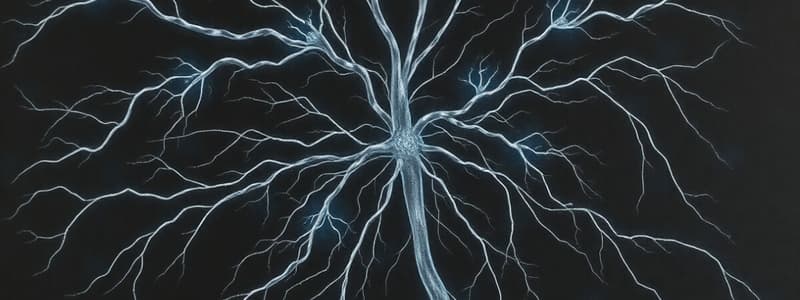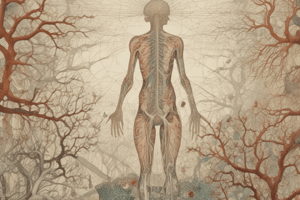Podcast
Questions and Answers
The nervous system works with which other system to control body functions and maintain homeostasis?
The nervous system works with which other system to control body functions and maintain homeostasis?
- Endocrine system (correct)
- Skeletal system
- Respiratory system
- Digestive system
Which division of the nervous system includes the brain and spinal cord?
Which division of the nervous system includes the brain and spinal cord?
- Peripheral Nervous System (PNS)
- Central Nervous System (CNS) (correct)
- Autonomic Nervous System (ANS)
- Somatic Nervous System (SNS)
Which of the following is a division of the peripheral nervous system?
Which of the following is a division of the peripheral nervous system?
- Brain
- All other nerves (correct)
- Spinal cord
- Cerebellum
The sensory division is part of which nervous system?
The sensory division is part of which nervous system?
Which of these is controlled by the somatic nervous system?
Which of these is controlled by the somatic nervous system?
What is the function of the autonomic nervous system?
What is the function of the autonomic nervous system?
Which of these is considered nervous tissue?
Which of these is considered nervous tissue?
What type of cells are Schwann cells?
What type of cells are Schwann cells?
Which of the following is a key feature of a neurone?
Which of the following is a key feature of a neurone?
What is the main function of the axon?
What is the main function of the axon?
What is the main function of the myelin sheath?
What is the main function of the myelin sheath?
What is the primary function of Schwann cells?
What is the primary function of Schwann cells?
What is the purpose of Nodes of Ranvier?
What is the purpose of Nodes of Ranvier?
What is the main function of dendrites?
What is the main function of dendrites?
What is irritability in the context of neurones?
What is irritability in the context of neurones?
What is conductivity in the context of neurones?
What is conductivity in the context of neurones?
Which of the following is a type of neuroglial cell?
Which of the following is a type of neuroglial cell?
Which cells form and maintain myelin in the central nervous system (CNS)?
Which cells form and maintain myelin in the central nervous system (CNS)?
What is the main function of microglia?
What is the main function of microglia?
What is the role of astrocytes in the nervous system?
What is the role of astrocytes in the nervous system?
What crosses the blood-brain barrier quickly?
What crosses the blood-brain barrier quickly?
What is the primary function of the blood-brain barrier?
What is the primary function of the blood-brain barrier?
What do synaptic end bulbs contain?
What do synaptic end bulbs contain?
What are the structures that store neurotransmitters in the synaptic end bulbs called?
What are the structures that store neurotransmitters in the synaptic end bulbs called?
Which of the following chemicals is a neurotransmitter?
Which of the following chemicals is a neurotransmitter?
Flashcards
Nervous System Function
Nervous System Function
The nervous system detects and responds to changes inside and outside the body, working with the endocrine system to maintain homeostasis.
Central Nervous System (CNS)
Central Nervous System (CNS)
The central nervous system consists of the brain and spinal cord.
Peripheral Nervous System (PNS)
Peripheral Nervous System (PNS)
The peripheral nervous system includes all nerves outside the brain and spinal cord.
PNS Sensory Division
PNS Sensory Division
Signup and view all the flashcards
PNS Motor Division
PNS Motor Division
Signup and view all the flashcards
Somatic Nervous System
Somatic Nervous System
Signup and view all the flashcards
Autonomic Nervous System
Autonomic Nervous System
Signup and view all the flashcards
Nervous tissue components
Nervous tissue components
Signup and view all the flashcards
Neurons
Neurons
Signup and view all the flashcards
Neuron Cell Body
Neuron Cell Body
Signup and view all the flashcards
Axon Function
Axon Function
Signup and view all the flashcards
Schwann Cells
Schwann Cells
Signup and view all the flashcards
Nodes of Ranvier
Nodes of Ranvier
Signup and view all the flashcards
Dendrites
Dendrites
Signup and view all the flashcards
Irritability (Neurons)
Irritability (Neurons)
Signup and view all the flashcards
Conductivity (Neurons)
Conductivity (Neurons)
Signup and view all the flashcards
Neuroglial Cells
Neuroglial Cells
Signup and view all the flashcards
Microglia Function
Microglia Function
Signup and view all the flashcards
Astrocytes
Astrocytes
Signup and view all the flashcards
Oligodendrocytes
Oligodendrocytes
Signup and view all the flashcards
Blood-Brain Barrier
Blood-Brain Barrier
Signup and view all the flashcards
Synaptic End Bulbs
Synaptic End Bulbs
Signup and view all the flashcards
Synapse
Synapse
Signup and view all the flashcards
Synaptic Vesicles
Synaptic Vesicles
Signup and view all the flashcards
Neurotransmitters
Neurotransmitters
Signup and view all the flashcards
Study Notes
- The nervous system detects and responds to changes inside and outside the body.
- Together with the endocrine system, the nervous system controls body functions and maintains homeostasis.
- Nervous system stimulation provides an immediate response, while endocrine activity is slower and more prolonged.
Divisions of the Nervous System
- There are two divisions of the nervous system.
- The central nervous system (CNS) consists of the brain and spinal cord.
- The peripheral nervous system (PNS) consists of all other nerves.
Peripheral Nervous System
- Sensory division
- Motor division
- Voluntary (somatic nervous system)
- Involuntary (autonomic nervous system)
- Sympathetic ("fight or flight")
- Parasympathetic ("rest and digest")
Nervous Tissue Cells
- Neurones
- Schwann Cells
- Neuroglial/Glial Cells
Key Features of a Neuron
- Cell body
- Axon
- Schwann cells
- Nodes of Ranvier
- Dendrites
- Synaptic end bulb
Axons
- They serve as a communication route between the cell body and axon terminals.
- Axons conduct electrical impulses away from the neuron's cell body.
- They are often longer than dendrites, sometimes exceeding 1 meter.
- Large axons and those in the peripheral nervous system are surrounded by a myelin sheath, which consists of a series of Schwann cells.
Schwann Cells
- Schwann cells wrap around the axon, forming layers.
- They mainly provide myelin insulation to axons in the peripheral nervous system.
- The myelin sheath has a high phospholipid (fatty) content, offering electrical insulation.
Nodes of Ranvier
- Nodes of Ranvier are exposed areas between Schwann cells.
- They assist in rapid transmission of action potentials in myelinated neurons.
Dendrites
- Dendrites are extensions of the cell body.
- They provide a large surface area to receive and pass information to the cell body.
- Dendrites share a similar structure to axons but are shorter.
- The plasma membrane contains dense chemical ion channels for impulse transmission.
- Dendrites form synapses with other dendrites or terminate in specialized sensory receptors like those in the skin.
Properties of Neurons
- Irritability: ability to initiate nerve impulses in response to stimuli from inside or outside the body.
- Conductivity: ability to transmit an impulse.
Neuroglial Cells
- Non-excitable glial (glue-like) cells support the neurones of the central nervous system.
- Unlike nerve cells, they continue to replicate throughout life
- Microglia
- Astrocytes
- Oligodendrocytes
Functions of Neuroglial Cells
- Microglia are mainly found in the area of blood vessels, enlarge, and become phagocytic in areas of inflammation and cell destruction.
- Astrocytes form the main supporting tissues of the central nervous system, are star-shaped with fine branching processes, lie in a mucopolysaccharide ground substance, and are found in large numbers adjacent to blood vessels.
- Oligodendrocytes, smaller than astrocytes, are found in clusters around the neurone cell wall, adjacent to, and along the length of many myelinated nerve fibres in the CNS.
- Oligodendrocytes form and maintain myelin and have the same function as Schwann cells in the peripheral nerves.
Blood-Brain Barrier
- It's a selective barrier that protects the brain from potentially toxic substances and chemical variations in the blood.
- Oxygen, carbon dioxide, glucose, and lipid-soluble substances like alcohol can quickly cross the barrier into the brain.
- Large molecules, drugs, inorganic ions, and amino acids pass slowly or not at all from the blood to the brain.
Synaptic End Bulbs
- Synaptic end bulbs are important for nerve impulse conduction from one neurone to another or from a neurone to an effector.
- They contain enclosed sacs called synaptic vesicles.
- Synaptic vesicles store neurotransmitters.
Synapse Components
- Pre-synaptic neurone
- Pre-synaptic knob
- Neurotransmitters (e.g., acetylcholine/noradrenaline)
- Calcium
- Mitochondria
- Neurotransmitter receptors
- Post-synaptic knob
- Post-synaptic neurone
Studying That Suits You
Use AI to generate personalized quizzes and flashcards to suit your learning preferences.




